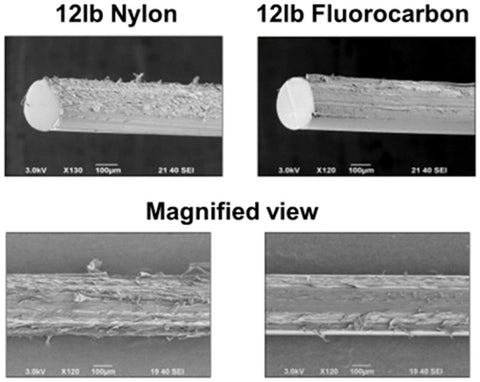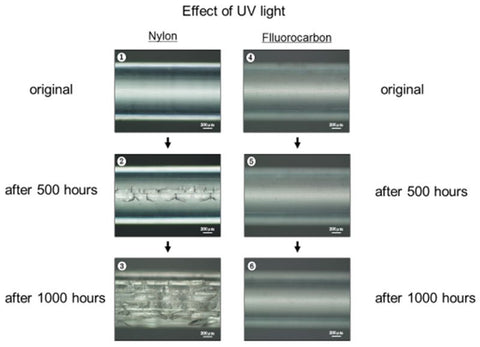Fishing with Fluorocarbon. Why use Fluorocarbon?

Many anglers want to know how to compare fluorocarbon and monofilament lines. Anglers in the US call nylon lines monofilament; for this article, we will call them nylon as that is the material they are made from. A monofilament line could be made from multiple materials that could each be a single monofilament, so it will be referenced as nylon in comparison in this article. This article outlines the key features of fluorocarbon and how it can help an angler catch more fish.
Fluorocarbon started as a leader material in saltwater but is now being used by many anglers as a mainline on reels. Since it was originally designed for leader use, the early fluorocarbons were very stiff and difficult to use on baitcasting or spinning reels. Anglers using these early fluorocarbons on baitcasting or spinning reels often had trouble with line handling, backlashes, and the line wanting to “jump off” spinning reels on its own. Advancements in the production of fluorocarbon have now made it a much better fit for use as a mainline on any reel. Fluorocarbon remains a great choice for leader materials to be used with braided lines.
100% fluorocarbon
Fluorocarbon is made from vinylidene fluoride resin and extruded into a single strand, similar to traditional nylon(monofilament) lines. If you would like to learn more about the history of fluorocarbon and fishing lines, this article contains a detailed history.

What are the primary reasons anglers choose fluorocarbon as a main line?
- Increased sensitivity. Fluorocarbon is a harder material, allowing it to transmit feedback from your lure better than softer nylon lines. The more line you have out or the longer the cast, the more this increased sensitivity can help you feel bites.
- Lower visibility. Fluorocarbon is harder to see in water than nylon. The light refraction index of fluorocarbon is closer to the refractive index of water than nylon; this makes it less visible and shiny in water. These things make it harder for fish to see. This makes it an excellent choice for anglers fishing in clear water or for pressure and line-shy fish. If fluorocarbon was invisible, anglers could use a large lb test no matter the condition and not spook fish from seeing their line. Fluorocarbon is less visible, particularly if it is a clearer premium brand; this will reduce the ability of fish to see the line. Fluorocarbon is not invisible, but it is less visible.
- Greater abrasion resistance. This diagram compares 12lb nylon to 12lb fluorocarbon after 10 strokes on an abrasion resistance testing machine with 1.3 lbs of weight shown under an electronic microscope.
- Less stretch. Which improves hooking ratios, especially on long casts. Fluorocarbon has less stretch than nylon lines, which helps improve hook penetration on hook sets. Nylon will stretch nearly a yard more than a premium fluorocarbon on a 33-yard cast. Think about how much line you must take up on a long cast to move your hook in a fish’s mouth.
- Lower water absorption. Nylon lines are often stronger than fluorocarbon until they get wet and absorb water, at which time they weaken. The repeated soaking and drying continue to weaken nylon after long-term use. Fluorocarbon has a very low water absorption rate, so its strength is not impacted like nylon after repeated use. This allows fluorocarbon to maintain its characteristics longer than nylon lines.
- Higher specific gravity. Nylon lines typically have a specific gravity of around 1.14, slightly higher than water, at 1.0. It will gradually sink, but very slowly. In contrast, fluorocarbon has a specific gravity of 1.78, meaning it sinks in water and makes your lures, like crankbaits, run deeper. The higher specific gravity also keeps the line down in the water and removes some slack.
- Less impact from ultra-violet light. Lines can be exposed to UV light while hanging on the shelf in stores when stored in a lighted space, or during use. Fluorocarbon is less impacted by UV light than nylon, allowing it to remain stronger and perform at the highest levels longer.
1&2

3

4

5 & 6

7

The knot an angler ties and how well it is tied can have the biggest impact on a line’s performance. If you are looking for easy knot instructions for a wide range of knots, you can see them here. This article also shows which knot Sunline testing has proven the most effective for fluorocarbon tied to a lure.
Also, 100% fluorocarbon lines are very different from fluorocarbon-coated lines. Coated lines only have a small amount of fluorocarbon applied to the surface compared to the surface of the nylon. While it does provide some improved abrasion resistance to the surface of the line, it does not improve visibility, sensitivity, or overall abrasion resistance the same as 100% fluorocarbon.
The image below shows a fluorocarbon-coated line where you can see it is only on the surface. The advantage of the fluorocarbon-coated lines is improved abrasion resistance at a lower cost than 100% fluorocarbon. Still, it does not compare to 100% fluorocarbon overall.

To see all of the fluorocarbon lines offered by Sunline please click here.

